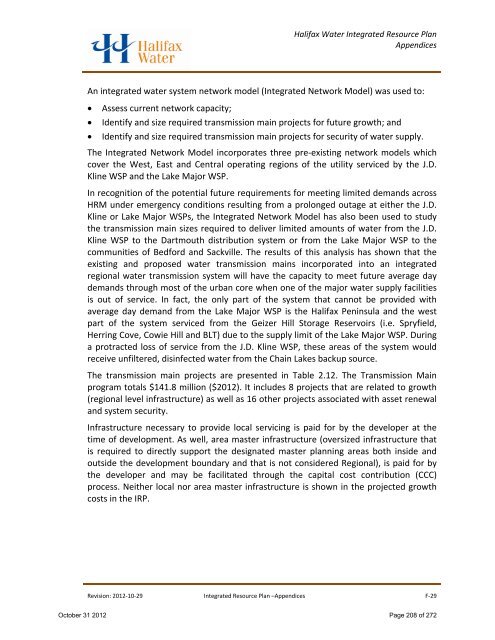volume 1 - Halifax Regional Municipality
volume 1 - Halifax Regional Municipality
volume 1 - Halifax Regional Municipality
Create successful ePaper yourself
Turn your PDF publications into a flip-book with our unique Google optimized e-Paper software.
<strong>Halifax</strong> Water Integrated Resource Plan<br />
Appendices<br />
An integrated water system network model (Integrated Network Model) was used to:<br />
• Assess current network capacity;<br />
• Identify and size required transmission main projects for future growth; and<br />
• Identify and size required transmission main projects for security of water supply.<br />
The Integrated Network Model incorporates three pre-existing network models which<br />
cover the West, East and Central operating regions of the utility serviced by the J.D.<br />
Kline WSP and the Lake Major WSP.<br />
In recognition of the potential future requirements for meeting limited demands across<br />
HRM under emergency conditions resulting from a prolonged outage at either the J.D.<br />
Kline or Lake Major WSPs, the Integrated Network Model has also been used to study<br />
the transmission main sizes required to deliver limited amounts of water from the J.D.<br />
Kline WSP to the Dartmouth distribution system or from the Lake Major WSP to the<br />
communities of Bedford and Sackville. The results of this analysis has shown that the<br />
existing and proposed water transmission mains incorporated into an integrated<br />
regional water transmission system will have the capacity to meet future average day<br />
demands through most of the urban core when one of the major water supply facilities<br />
is out of service. In fact, the only part of the system that cannot be provided with<br />
average day demand from the Lake Major WSP is the <strong>Halifax</strong> Peninsula and the west<br />
part of the system serviced from the Geizer Hill Storage Reservoirs (i.e. Spryfield,<br />
Herring Cove, Cowie Hill and BLT) due to the supply limit of the Lake Major WSP. During<br />
a protracted loss of service from the J.D. Kline WSP, these areas of the system would<br />
receive unfiltered, disinfected water from the Chain Lakes backup source.<br />
The transmission main projects are presented in Table 2.12. The Transmission Main<br />
program totals $141.8 million ($2012). It includes 8 projects that are related to growth<br />
(regional level infrastructure) as well as 16 other projects associated with asset renewal<br />
and system security.<br />
Infrastructure necessary to provide local servicing is paid for by the developer at the<br />
time of development. As well, area master infrastructure (oversized infrastructure that<br />
is required to directly support the designated master planning areas both inside and<br />
outside the development boundary and that is not considered <strong>Regional</strong>), is paid for by<br />
the developer and may be facilitated through the capital cost contribution (CCC)<br />
process. Neither local nor area master infrastructure is shown in the projected growth<br />
costs in the IRP.<br />
Revision: 2012-10-29 Integrated Resource Plan –Appendices F-29<br />
October 31 2012 Page 208 of 272
















